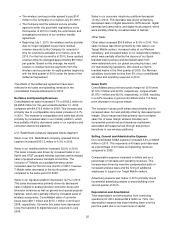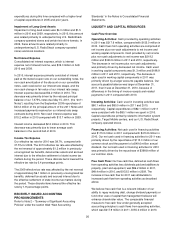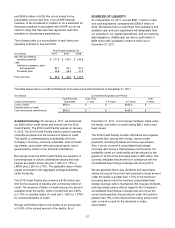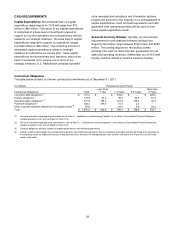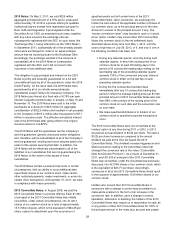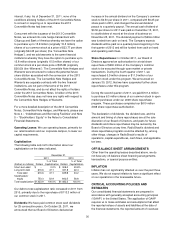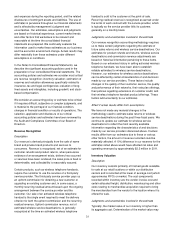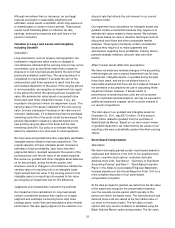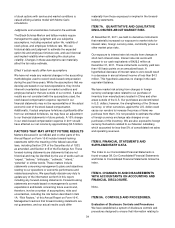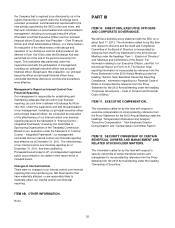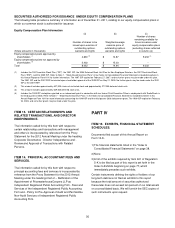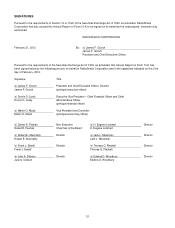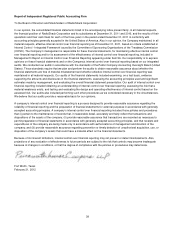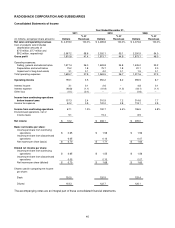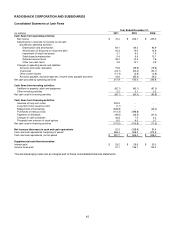Radio Shack 2011 Annual Report Download - page 42
Download and view the complete annual report
Please find page 42 of the 2011 Radio Shack annual report below. You can navigate through the pages in the report by either clicking on the pages listed below, or by using the keyword search tool below to find specific information within the annual report.34
of stock options with service and market conditions is
valued utilizing a lattice model with Monte Carlo
simulations.
Judgments and uncertainties involved in the estimate
The Black-Scholes-Merton and lattice models require
management to apply judgment and use subjective
assumptions, including expected option life, volatility of
stock prices, and employee forfeiture rate. We use
historical data and judgment to estimate the expected
option life and employee forfeiture rate, and use historical
and implied volatility when estimating the stock price
volatility. Changes in these assumptions can materially
affect the fair value estimate.
Effect if actual results differ from assumptions
We have not made any material changes in the accounting
methodologies used to record stock-based compensation
during the past three years. While the assumptions that we
develop are based on our best expectations, they involve
inherent uncertainties based on market conditions and
employee behavior that are outside of our control. If actual
results are not consistent with the assumptions used, the
stock-based compensation expense reported in our
financial statements may not be representative of the actual
economic cost of the stock-based compensation.
Additionally, if actual employee forfeitures significantly differ
from our estimated forfeitures, we may have an adjustment
to our financial statements in future periods. A 10% change
in our stock-based compensation expense in 2011 would
have affected our net income by approximately $0.5 million.
FACTORS THAT MAY AFFECT FUTURE RESULTS
Matters discussed in our MD&A and in other parts of this
Annual Report on Form 10-K include forward-looking
statements within the meaning of the federal securities
laws, including Section 27A of the Securities Act of 1933,
as amended, and Section 21E of the Exchange Act. These
forward-looking statements are statements that are not
historical and may be identified by the use of words such as
“expect,” “believe,” “anticipate,” “estimate,” “intend,”
“potential” or similar words. These matters include
statements concerning management’s plans and objectives
relating to our operations or economic performance and
related assumptions. We specifically disclaim any duty to
update any of the information set forth in this report,
including any forward-looking statements. Forward-looking
statements are made based on management’s current
expectations and beliefs concerning future events and,
therefore, involve a number of assumptions, risks and
uncertainties, including the risk factors described in Item
1A, “Risk Factors,” of this Annual Report on Form 10-K.
Management cautions that forward-looking statements are
not guarantees, and our actual results could differ
materially from those expressed or implied in the forward-
looking statements.
ITEM 7A. QUANTITATIVE AND QUALITATIVE
DISCLOSURES ABOUT MARKET RISK.
At December 31, 2011, we held no derivative instruments
that materially increased our exposure to market risks for
interest rates, foreign currency rates, commodity prices or
other market price risks.
Our exposure to interest rate risk results from changes in
short-term interest rates. Interest rate risk exists with
respect to our cash equivalents of $426.2 million at
December 31, 2011. These instruments currently yield less
than 100 basis points on an annualized basis. A
hypothetical decrease of interest rates to zero would result
in a decrease in annual interest income of less than $4.3
million. This hypothesis assumes no change in the cash
equivalent balance.
We have market risk arising from changes in foreign
currency exchange rates related to our purchase of
inventory from manufacturers located in China and other
areas outside of the U.S. Our purchases are denominated
in U.S. dollars; however, the strengthening of the Chinese
currency, or other currencies, against the U.S. dollar could
cause our vendors to increase the prices of items we
purchase from them. It is not possible to estimate the effect
of foreign currency exchange rate changes on our
purchases of this inventory. We are also exposed to foreign
currency fluctuations related to our Mexican subsidiary,
which accounted for less than 5% of consolidated net sales
and operating revenues.
ITEM 8. FINANCIAL STATEMENTS AND
SUPPLEMENTARY DATA.
The Index to our Consolidated Financial Statements is
found on page 38. Our Consolidated Financial Statements
and Notes to Consolidated Financial Statements follow the
index.
ITEM 9. CHANGES IN AND DISAGREEMENTS
WITH ACCOUNTANTS ON ACCOUNTING AND
FINANCIAL DISCLOSURE.
None.
ITEM 9A. CONTROLS AND PROCEDURES.
Evaluation of Disclosure Controls and Procedures
We have established a system of disclosure controls and
procedures designed to ensure that information relating to



